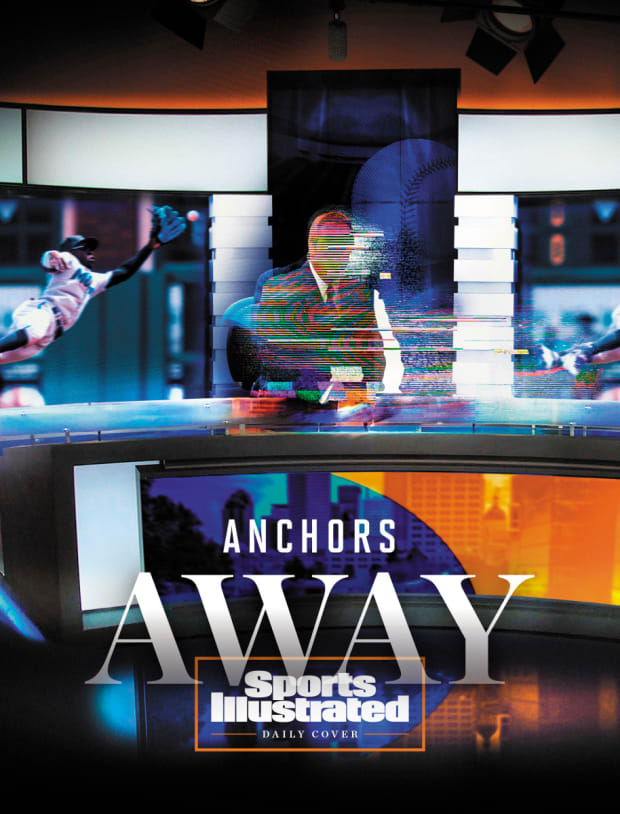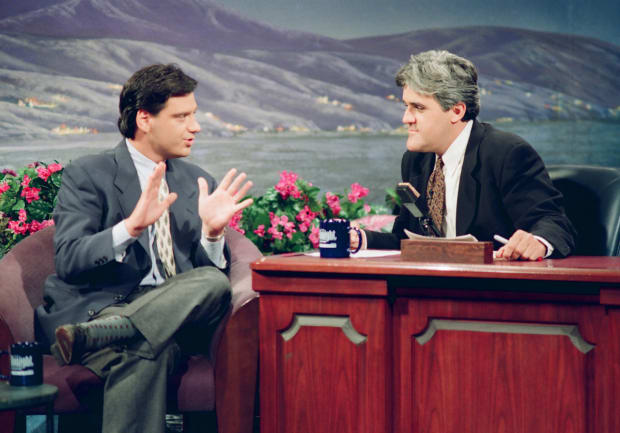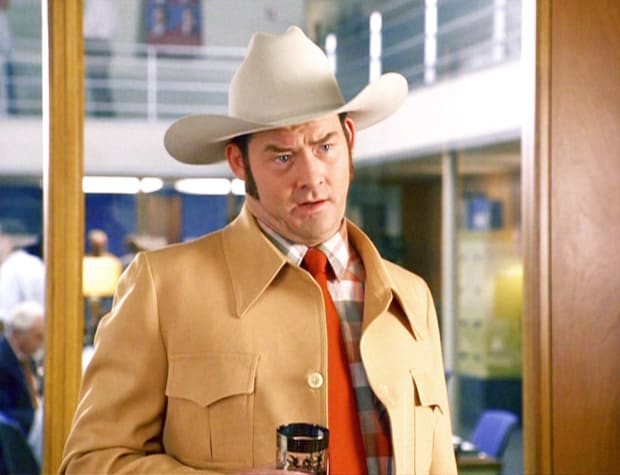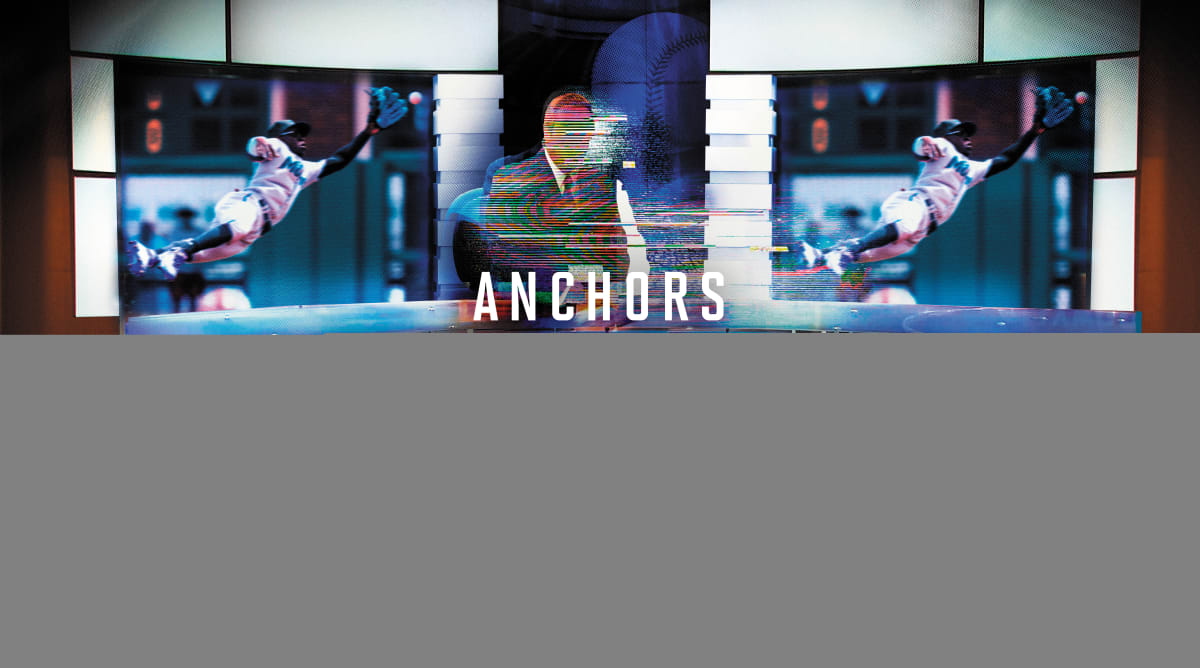They were once gods walking among mere mortals. Now they’re lucky to get two minutes.
In 1980, Fred Roggin moved from Arizona to Los Angeles to become the local sports anchor for KNBC-TV, where, night after night, he put on his uniform and took his place in the lineup, batting third, following news and weather. When it was his turn to do his thing, he’d clear his throat, his producer would count him down and then he’d spend five (then eventually four, then three) minutes delivering sports news and highlights.
With a mix of levity and gravity, Roggin recounted the exploits of the Dodgers, from Fernando Valenzuela to Clayton Kershaw. He told his viewers about the triumphs of Magic and Kareem, then Shaq and Kobe, then LeBron. He broadcast from the 1984 Olympics; he broadcast when L.A. was awarded the 2028 Summer Games. And it wasn’t just local highlights. Was there a frenetic play from a Nuggets game? A triple play from an A’s game? A title fight? A waterskiing squirrel? As the countless commercials that aired throughout the 1980s promised, “If it sweats, Fred’ll show it to you.”

Illustration by The Sporting Press
Roggin was ubiquitous in Southern California, more recognized around town than most of the athletes he covered. Yes, it was all that nightly airtime, but it also owed to all that local promotion. Keith Olbermann, another L.A. sports anchor in the 1980s, once remarked, “During an earthquake, your chances were one in three of being crushed by a Fred Roggin billboard.”
Thursday, Jan. 26, 2023, marked Roggin’s final sportscast on KNBC, the last installment of what he branded “The Dean’s Office.” It was his last call for a Los Angeles institution, closing time for a familiar fixture that had persisted in the market for more than 42 years.
The occasion may have warranted a grand on-air farewell. But as the newscast began, there was a car chase on the 55 North. By the time Roggin’s segment finally rolled around, he grinned through clenched teeth and began with the ad-lib: “If that chase had continued, I was going to be so angry. I called the [California Highway Patrol] and I said, ‘Pit that guy.’ Don’t you understand it’s the final show of ‘The Dean’s Office,’ and it has to go on at 5:23? We have seven people watching!”
Roggin, 65, then spent his allotted four minutes pacing the studio, expressing his appreciation for colleagues and family and viewers. He used the occasion to plug his radio show “every day at noon on AM 570.” He closed pointedly, by saying, “Until we meet again on a device, be it streaming or linear TV . . . I’ll NBC you later.”
As a nostalgic goodbye segment for an on-air stalwart of more than four decades, it was underwhelming. As an encapsulation of the muffled voice and drained status of the local sports anchor, it was pitch perfect.
For decades, in most markets, the local sports anchor was as recognized as the mayor. Except that he—and, inevitably, this figure was a man—had a higher approval rating and wasn’t boxed in by term limits.

Margaret Norton/NBCU Photo Bank/NBCUniversal/Getty Images
Name a major U.S. city and, odds are good, you can associate it with a long-serving, blazer-clad, impeccably coiffed, honey-voiced anchor. Warner Wolf (and then Len Berman and then Bruce Beck) in New York. Glenn Brenner and George Michael in D.C. Roggin and Jim Hill in L.A. Dale Hansen in Dallas. Bob Lobel in Boston. Bernie Smilovitz in Detroit. Mark Rosen in Minneapolis. Dennis Janson in Cincinnati. Champ Kind in San Diego. The last one is a joke, of course. But Anchorman had it right when it observed: “There was a time, a time before cable, when the local anchor reigned supreme. . . . He was like a god walking amongst mere mortals.”
Like a reliable friend, the local sports anchor was there at the appointed time, offering companionability as he provided news and highlights not easily obtained elsewhere. Unfailingly, it all came deployed with a heavy dose of humor (and homerism). It was all but an occupational requirement to have a schticky catchphrase; a particular cadence; a distinguishing characteristic, which ranged from inane (zany sweaters!) to quirky (Don Hein, sports guy for the NBC affiliate in my childhood market of Indianapolis, sometimes played tuba on the air).
And beyond the broadcasts, often these men were tentpoles of the community, appearing at schools and malls and churches, hosting graduations and fundraisers.
They had sandwiches named in their honor. They endorsed local car dealerships. Roggin’s predecessor at KNBC, Stu Nahan, made a memorable cameo in Fast Times at Ridgemont High. When they walked into restaurants, they received backslaps and autograph requests. Someone else picked up their bar tabs. Or greens fees. Or even their country club dues.
Not that the local sports anchor couldn’t afford the purchases himself. In that “time before cable,” it was not uncommon for half the households in a community to tune into local news. And sports anchors were paid accordingly, able to earn seven-figure salaries in a large market and high six figures in plenty of places elsewhere. “Let’s be honest,” Roggin concedes, “in local news, we were all overpaid for a lot of years. The stations made a lot of money, and we were handsomely compensated.”
How much so? In 1981, Washington’s WDVM-TV 9 poached the charismatic Brenner from Philadelphia. With the breathlessness reserved for covering a football free-agent signing, The Washington Post wrote about Brenner’s five-year, $3.5 million deal, which included $200,000 for his children’s education and a $50,000 signing bonus. This, again, was ’81, when annual per-capita income was $13,976.
Local sports anchoring was once a major pathway to network prominence. Bryant Gumbel was one of the evening sports anchors before Roggin at KNBC. Marv Albert was once a nightly presence in New York. Al Michaels got his start at the local affiliate in Honolulu. Ernie Johnson worked the news side in Macon, Ga.; then Spartanburg, S.C.; then Atlanta. But by the 1980s, national networks would inquire about the services of the local sports anchors—only, often, to be turned away. “These guys might want to do a game or an event, go work an Olympics maybe,” Michaels once told me. “But why leave [to go a national network full time]? You’re paid well. You’re treated like a king in your community. You get to sleep in your own bed. It was a good gig!”
Until it wasn’t.

CBS/Getty Images
The first big blow to local sports anchors was delivered by ESPN. When an all-sports network hit the air in 1979, concurrent with the explosion of cable, fans no longer needed to rely on the guy at the local station. SportsCenter came on at the same time as local news, siphoning viewers. And it was a full hour of sports highlights. The show had more production value than a local newscast. The highlights themselves were longer and more nuanced. The banter between the hosts was far more entertaining than the chatter between the sports guy and the meteorologist.
Some local sports anchors did what they could to confront the challenge. In D.C., Michael’s Sports Machine was, for a time, a sort of network alternative to SportsCenter, a half-hour highlights show syndicated nationally. (It was popular enough that it earned a spoof on Saturday Night Live.) In the early 1990s, Roggin created Roggin’s Heroes, which in retrospect was a precursor to TikTok, a slickly produced compendium of highlights and bloopers and the kind of videos that would go viral today. It, too, was syndicated.
Still, the ratings of local news began a steep and steady decline. As local newscasts lost, in some cases, more than 50% of their viewership between 2010 and ’20, sports segments got less and less airtime. The sports anchor began to decline in stature. More important, stations tried to reduce pay. One Washington, D.C., sports anchor tells of starting a job in the late 1990s: When his contract came up for negotiation after two years, he was offered to return at half salary. Surveying the market and realizing the state of play nationwide, he grudgingly accepted.
Then came mobile technology. Soon, everyone with a phone had access not just to real-time results, but to highlights of every dunk and touchdown and brawl that emerged seconds after they happened.
Most news stations did remarkably little to adapt. On this point, Roggin doesn’t mince words. “I started in Yuma, Arizona, 46 years ago. We’re still doing the exact same thing the exact same way. Do we take pictures the same way we used to when we were growing up? No. My parents would tell us, run away from strangers and don’t ever get in their car. We get into Ubers all the time now. We have electric cars now. Electric! So everything has evolved and changed. The only thing that has stayed the exact same is what we do.” He calls the decline of the local sports anchor “a self-fulfilling prophecy. . . . Simply sitting there and regurgitating highlights and scores is not compelling. All you’re doing is giving people what they already have and already know.”
Given that the sportscast was often the lowest-rated segment of the broadcast, it was especially hard hit by ratings declines. The local sports anchor was asked to “do more with less,” blogging and going in the field and shooting his own video.
Again, some of the more resourceful sports anchors tried to innovate. In Dallas, Hansen began using his platform to stare into the camera and deliver political commentary, some of which went viral. In L.A., Roggin took a hyperlocal approach, devoting more time to high schools, rebranding Roggin’s Heroes into a show about SoCal athletes who wouldn’t otherwise be on highlights shows. Less enterprisingly, a Boston station announced in January it was testing a 6 p.m. newscast with no sports at all.
Roggin isn’t quite ready to administer a final result to the local sportscaster. He suggests that they swap what for why. “Offer perspective and analysis and opinion,” he says. “Anyone can say, ‘The Lakers had a team meeting.’ But tell people why they had that meeting. And what it meant. Give people something that they can’t get somewhere else. That’s how it survives.”
As for his own survival, he will continue with his radio show and says, “There are opportunities already in place for me to produce shows I enjoy doing and host them and create other content.” Still, he acknowledges that the local sports anchor is becoming a cultural relic.
Asked how one could see a clip of his final broadcast, Roggin says without hesitation: “Is it up on YouTube?”


















